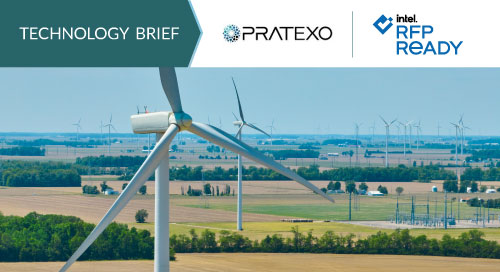Fill form to unlock content
Error - something went wrong!
Your content is just a step away. Please submit below.
Thank you!
Distributed Computing Powers the Smart Grid

Blaine Mathieu is the face of changes reshaping the power distribution landscape.
His home houses a 30-kilowatt solar array on the roof that he uses to route electricity back to the grid. Mathieu, CEO of Pratexo, an edge computing software platform for utilities, is a “prosumer,” an individual who both consumes and produces electricity.
Such two-way energy flow is not the only change in utilities. To avoid global temperature increases and the worst fallout from climate change, the integrated energy system of the future must decarbonize. It must shift to 50-80% direct electricity by 2050 (instead of the 20% it is now), according to the World Economic Forum.
Decarbonization and the increase in electric vehicles are also adding unpredictability into the mix, Mathieu says. “As a result, we’re quickly moving away from the sequential, well-ordered centralized model of energy production to a decarbonized, decentralized, democratized, and digitalized one,” Mathieu observes, quoting recent Gartner research in this area.
The push-and-pull forces in power production are forcing the sector to move away from a mindset of viewing systems as being “built to last.” Instead, they need to be smart grids, “built for change,” Mathieu says. Such a mindset reboot is a radical transformation and “only software can enable that kind of rapid evolution and change,” he adds.
To accommodate the rapid evolution and change that they must go through, the utilities industry leans on asset-derived #IoT #data at the edge—where the sensors and machines operate. @pratexo via @insightdottech
Decentralized Power and Distributed Computing
To accommodate the rapid evolution and change that they must go through, the utilities industry leans on asset-derived IoT data at the edge—where the sensors and machines operate. The premise is that applying AI and machine learning-derived insights from IoT data streams will enable utilities to become more efficient.
And to gain these advantages, it is much more efficient to bring the algorithm to the data at the edge than the other way around. “When you’ve got hundreds of windmills generating gigabytes of data every day, you can’t possibly push all that into a central cloud,” Mathieu says. “Instead, what you should be doing is preprocessing some if not all that raw data locally, and then send only a lighter event stream of important events up to the cloud for further analysis.”
It’s a convincing argument for the deployment of distributed computing to deliver edge analytics.
The cost of moving data to and from the cloud is not the only factor influencing the move to distributed computing, Mathieu says. The grid needs to be constantly monitored and changes reacted to in a matter of milliseconds. In such instances, the low latency from distributed computing on the edge is also especially attractive.
Making Way for Electric Grid Evolution
Distributed computing might be the way for today’s decentralized power grids, but it lacks the seamless orchestration powers of cloud computing. In the distributed computing model, far-flung edge nodes close to the transformers in the field have to be managed and orchestrated remotely. Seamless it ain’t.
But with Pratexo, power utilities can have their cake and eat it, too: They can deploy a distributed computing model for the edge and still enjoy the orchestration and management ease of cloud computing, Mathieu says.
The Smart Grid in Norway
Norwegian utilities services provider Hallingdal Kraftnett (HKN) is a perfect example of the Pratexo Intelligent Energy Grid solution at work.
More than 70% of the vehicles in Norway are electric cars, which creates enormous strains on the grid. HKN manages more than 3,000 remote transformer stations and needs to respond to problems, if any, in milliseconds.
Because the Intelligent Grid Monitoring solution is a framework pre-architected and custom-made for grid monitoring with a set of dashboards, basic analytics, and integrations with hardware already in place, Pratexo simply had to mix-and-match a few Lego blocks to develop a custom solution for HKN.
The HKN drag-and-drop solution includes an integration with transformer equipment, an external power meter, humidity meter, and temperature sensor. It also uses a microphone that listens to transformer sounds to detect a crackling sound called partial discharge. An audio wave analyzer machine learning algorithm processes these sounds and alerts maintenance teams faster than standard manual inspection protocols.
Edge nodes at each substation process data locally, which are then routed to regional micro clouds formed across the remote transformer stations. Such decreased latency helps HKN deploy condition-based maintenance and react within seconds to problems. As a result, they avoid steep penalties that would result from outages.
All Pratexo deployments have been on the backs of Intel processors. “Virtually all of the software components and elements of the platform that we deploy were written to be compatible with Intel first,” Mathieu says, adding that the company has built an integration with the Intel® OpenVINO™ toolkit for AI processing of edge implementations in other applications.
The Future of the Electric Grid
The flexible and composable software that Pratexo delivers is what’s needed to pick up the pace in addressing climate change, Mathieu says.
“Instead of deploying a hardware and software architecture that is static and difficult to change, you shift your technology mindset toward composability, which means the ability to rapidly swap out and change or enhance individual components as necessary,” Mathieu says. This way we create a smart grid, easily adaptable to change.
“Software’s constantly changing. If we can adopt the best elements of software and apply it to utilities and electrification, that’s the only way we’re going to achieve the goals in front of us,” Mathieu says.
Which is a good thing, especially as the realities of climate change are becoming worryingly apparent by the day.
Edited by Georganne Benesch, Associate Editorial Director for insight.tech.